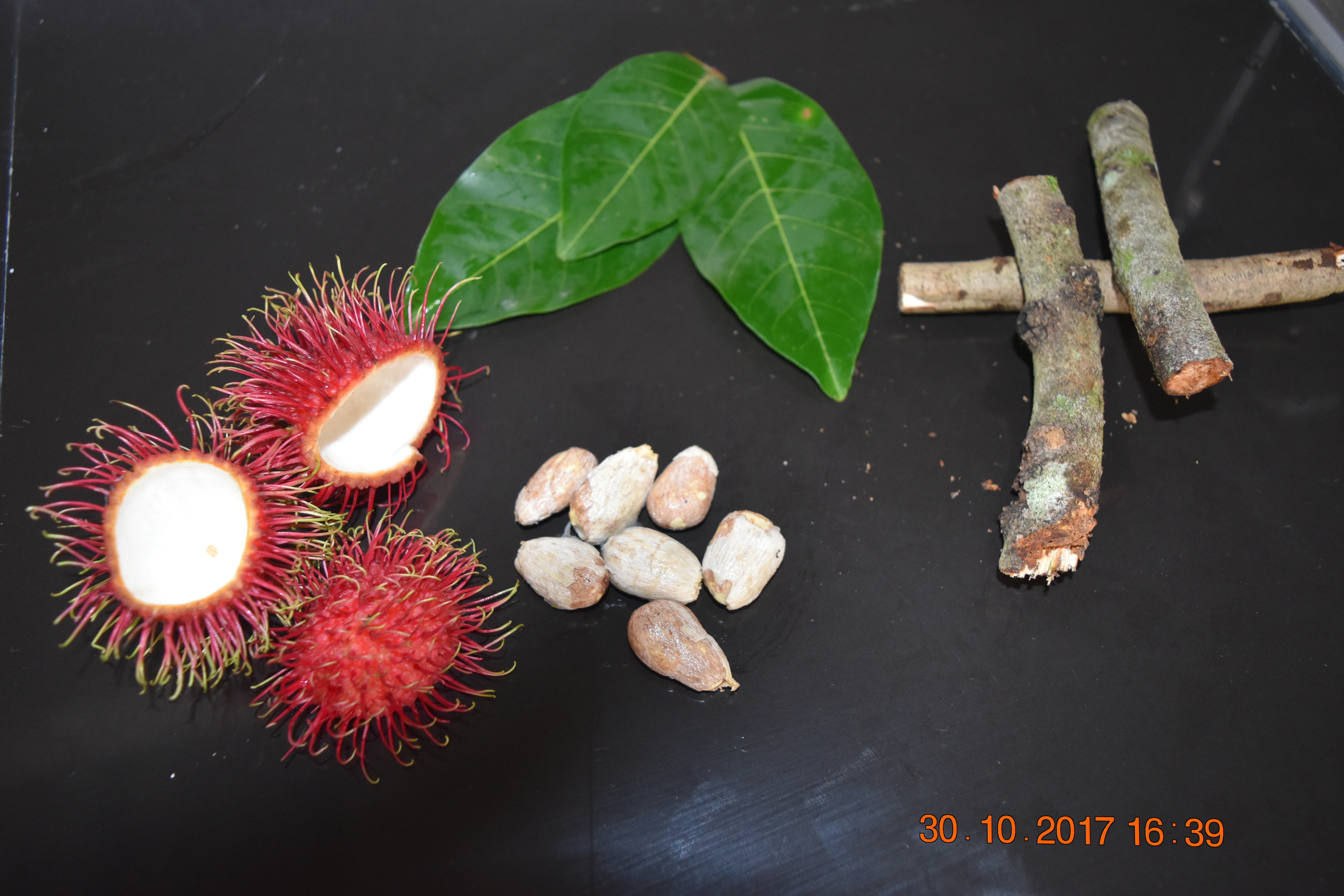Macronutrient content and distribution in rambutan on the atlantic coast of Honduras
DOI:
https://doi.org/10.15517/am.v31i3.40421Keywords:
Nephelium lappaceum L., tropical fruits, mineral nutriton, nutrients in leavesAbstract
Introduction. Rambutan productivity depends on satisfying its nutritional demand through the use of fertilizers. Knowing the quantity and the times of greatest demand for nutrients by the plant allows the producer to improve fertilization programs. Objective. To evaluate the content and distribution of macronutrients in different ages of the rambutan crop. Materials and methods. An experiment was established in the Atlantic coast of Honduras under a completely randomized design with six treatments (sampling at 2, 3, 4, 8, 10, and 17 years of establishment) and three repetitions. The study was carried out between the months of March and December 2017. At harvest time, leaves, branches, shells, and seeds were collected to analyze the concentrations of N, P, K, Ca, Mg, and S in each one. Results. It was recorded that the macronutrient concentration differed significantly among the organs and ages of the plant, finding the highest concentration of N, Ca, Mg, and S in leaves, P in seed and K in the shell. The total concentration (leaf + branch + shell + seed) of the nutrients registered fluctuations over time and increased the demand for P, K, Ca, and Mg in years 2 and 3, to then decline in years 8 and 10. While the demand for N and S were constant during the development stages. In addition, N (41 %) was required in greater quantities, followed by K (24 %) and Ca (20 %) and finally P (6 %), Mg (5 %) and S (4 %). Conclusion. The content and distribution of macronutrients were variable according to the age of the plant, allowing the identification of which nutrients and when they were most required and the plant organ where it was accumulated.
Downloads
References
Amézquita, E., J. Ashby, E.K. Knapp, R. Thomas, K. Müller-Sämann, H. Ranvorg, J. Beltrán, J.I. Sanz, I.M. Rao, and E. Barrios. 1998. CIAT’s strategic research for sustainable land management on the steep hillsides of Latin America. En: F.W.T. Penning-de-Vries et al., editors, Soil erosion at multiple scales: principles and methods for assessing causes and impacts. CAB International, Wallingford, UK, p. 121-132.
Arias, T.M., y V.I. Calvo. 2014. El cultivo de rambután o mamón chino. MAG-INTA-FITTACORI, San José, CRI.
Balsberg-Pahlsson, A.M. 1990. Influence of aluminum on biomass, nutrients, soluble carbohydrate and phenols in beech (Fagus sylvatica). Physiol. Plant. 78:79-84. doi:10.1111/j.1399-3054.1990.tb08718.x
Castro, H. 2004. Propuesta guía de indicadores analíticos para calificar suelos estables y en proceso de degradación desde el punto de vista físico. En: CIAT, editor, Memorias I Taller Nacional sobre indicadores de calidad del suelo. CIAT, Palmira, Valle, COL. p. 37-42.
FHIA (Fundación Hondureña de Investigación Agrícola), y SOCODEVI (Sociedad de Cooperación para el Desarrollo Internacional). 2018. Guía técnica: Producción de rambután en sistemas agroforestales. FHIA, y SOCODEVI, HON.
Gardi, C., M. Angelini, S. Barceló, J. Comerma, C. Cruz-Gaistardo, A. Encina-Rojas, A. Jones, P. Krasilnikov, M.L. Mendonça-Santos-Brefin, L. Montanarella, O. Muñiz-Ugarte, P. Schad, M.I. Vara-Rodríguez, y R. Vargas. 2014. Atlas de suelos de América Latina y el Caribe. Comisión Europea, Ciudad de Luxembourg, LUX.
Giller, K. 2001. Nitrogen fixation in tropical crooping systems. CAB International, Wallingford, GBR.
Goenaga, R. 2011. Dry matter production and leaf elemental concentrations of rambutan grown on an acid Ultisol. J. Plant Nutr. 34:753-761. doi:10.1080/01904167.2011.540690
Hernández, H.D., C.N. Aguilar, R. Rodríguez-Herrera, A.C. Flores-Gallegos, J. Morlett-Chávez, M. Govea-Salas, y J.A. Ascacio-Valdés. 2019. Rambután (Nephelium lappaceum L.): Una revisión general. JBCT 11(21):7-13.
Jordan, F., W. Jody, E. Glenn, L. Sam, T. Thompson, and T. Lewis. 2008. Natural bioremediation of a nitrate-contaminated soil-and-aquifer system in a desert environment. J. Arid Environ. 72:748-763. doi:10.1016/j.jaridenv.2007.09.002
Lim, T.K., L. Luders, Y. Dieczbalis, and M. Poffley. 1997. Rambutan nutrient requirement and management. Darwin: Department of Primary Industry and Fischeries, AUS.
Ng, S.K., and S. Thamboo. 1967. Nutrient removal studies on Malaysian fruits – durian and rambutan. Malaysian Agric. J. 46:164-183.
Rao, I.M. 2009. Essential plant nutrients and their functions. Working Document No. 36. CIAT, Cali, COL.
Salisbury, B.F., y C. W. Ross. 1994. Fisiología vegetal. Editorial Iberoamérica, Ciudad de México, MEX.
SAS Institute. 2002. Statistical analysis software Versión 9.1.3. SAS Institute Inc., Cary, NC, USA.
Vargas-Calvo, A. 2009. Síntomas asociados con altas concentraciones de boro en rambután (Nephelium Lappaceum). Agron. Mesoam. 20:121-126. doi:10.15517/AM.V20I1.4987.
Woomer, P.L., A. Martin, A. Albretch, D.V.S. Resck, and H.W. Scharpenseel. 1994. The importance and management of soil organic matter in the tropics. In: P.L. Woomer, and M.J. Swift, editors, The biological management of tropical soil fertility. Wiley & Sons, and TSBF, GBR. p. 47-80.

Downloads
Additional Files
Published
How to Cite
Issue
Section
License
1. Proposed policy for open access journals
Authors who publish in this journal accept the following conditions:
a. Authors retain the copyright and assign to the journal the right to the first publication, with the work registered under the attribution, non-commercial and no-derivative license from Creative Commons, which allows third parties to use what has been published as long as they mention the authorship of the work and upon first publication in this journal, the work may not be used for commercial purposes and the publications may not be used to remix, transform or create another work.
b. Authors may enter into additional independent contractual arrangements for the non-exclusive distribution of the version of the article published in this journal (e.g., including it in an institutional repository or publishing it in a book) provided that they clearly indicate that the work was first published in this journal.
c. Authors are permitted and encouraged to publish their work on the Internet (e.g. on institutional or personal pages) before and during the review and publication process, as it may lead to productive exchanges and faster and wider dissemination of published work (see The Effect of Open Access).























